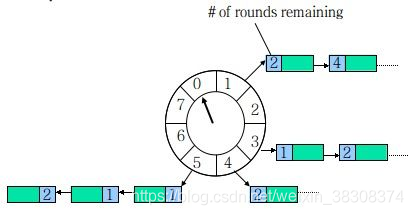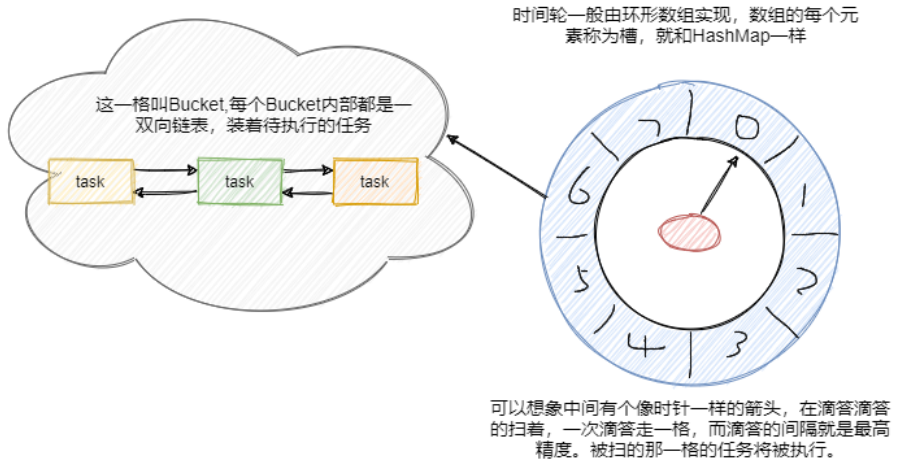Dubbo中失败重试的设计(十一)
在Dubbo中,有很多地方涉及到服务失败重试,比如之前说的服务注册失败时,会调用一个方法把失败的请求保存起来进行重试。那Dubbo中是怎么来实现失败重试的呢?这里有个很有意思的设计,就是采用时间轮机制
出现失败重试采用时间轮的代码
注册中心失败重试
private void addFailedRegistered(URL url) { FailedRegisteredTask oldOne = failedRegistered.get(url); if (oldOne != null) { return; } FailedRegisteredTask newTask = new FailedRegisteredTask(url, this); oldOne = failedRegistered.putIfAbsent(url, newTask); if (oldOne == null) { // never has a retry task. then start a new task for retry. retryTimer.newTimeout(newTask, retryPeriod, TimeUnit.MILLISECONDS); } }
clusterInvoker失败重试
private void addFailed(LoadBalance loadbalance, Invocation invocation, List<Invoker<T>> invokers, Invoker<T> lastInvoker) { if (failTimer == null) { synchronized (this) { if (failTimer == null) { failTimer = new HashedWheelTimer( new NamedThreadFactory("failback-cluster-timer", true), 1, TimeUnit.SECONDS, 32, failbackTasks); } } } RetryTimerTask retryTimerTask = new RetryTimerTask(loadbalance, invocation, invokers, lastInvoker, retries, RETRY_FAILED_PERIOD); try { failTimer.newTimeout(retryTimerTask, RETRY_FAILED_PERIOD, TimeUnit.SECONDS); } catch (Throwable e) { logger.error("Failback background works error,invocation->" + invocation + ", exception: " + e.getMessage()); } }
他们都是基于HashedWhelloTimer这个类来实现的。
什么是时间轮
时间轮这个技术其实出来很久了,在kafka、zookeeper等技术中都有时间轮使用的方式。例如电商中整体架构设计时需要考虑到超时订单的自动关单,而订单交易量又特别多,直接去轮询数据的效率有点低,所以这时就可以用上时间轮了。
简单来说: 时间轮是一种高效利用线程资源进行批量化调度的一种调度模型。把大批量的调度任务全部绑定到同一个调度器上,使用这一个调度器来进行所有任务的管理、触发、以及运行。所以时间轮的模型能够高效管理各种延时任务、周期任务、通知任务。 如果在工作中遇到类似的功能,可以采用时间轮机制。

时间轮,从图片上来看,就和手表的表圈是一样,所以称为时间轮,是因为它是以时间作为刻度组成的一个环形队列,这个环形队列采用数组来实现,数组的每个元素称为槽,每个槽可以放一个定时任务列表,叫HashedWheelBucket,它是一个双向链表,链表的每一项表示一个定时任务项(HashedWhellTimeout),其中封装了真正的定时任务TimerTask。
时间轮是由多个时间格组成,下图中有8个时间格,每个时间格代表当前时间轮的基本时间跨度(tickDuration),其中时间轮的时间格的个数是固定的。
在下图中,有8个时间格(槽),假设每个时间格的单位为1s,那么整个时间轮走完一圈需要8s钟。每秒钟指针会沿着顺时针方向移动一个,这个单位可以设置,比如以秒为单位,可以以一小时为单位,这个单位可以代表时间精度。
通过指针移动,来获得每个时间格中的任务列表,然后遍历这一个时间格中的双向链表来执行任务,以此循环。

时间轮的运行逻辑
首先,时间轮在启动的时候,会记录一下当前启动时间,并赋值给一个叫startTime的变量。然后当需要添加任务的时候,首先会计算延迟时间(deadline),比如一个任务的延迟时间是24ms,那么在添加任务时,会将当前时间(currentTime)+24ms-时间轮的启动时间(startTime),然后把这个任务封装成HashedWheelTimeout加入到链表中。那么这个任务应该放在哪个时间格里面呢? deadline%wheel.length
deadline= System.nanoTime() + unit.toNanos(delay) - startTime;
系统当前时间+延迟时间-时间轮启动的时间
时间轮在运行的时候,会从任务队列中取出10W个进行遍历处理。大概理解了时间轮的原理,我们再去看看时间轮的源码Dubbo中的时间轮实现类是:HashedWheelTimer。
在FailbackClusterInvoker这个类中,构建了一个HashedWheelTimer,然后增加了一个任务RetryTimerTask到时间轮中。基于这段代码, 我们去分析一下HashedWheelTimer的实现。
private void addFailed(LoadBalance loadbalance, Invocation invocation, List<Invoker<T>> invokers, Invoker<T> lastInvoker) { if (failTimer == null) { synchronized (this) { if (failTimer == null) { failTimer = new HashedWheelTimer( new NamedThreadFactory("failback-cluster-timer", true), 1, TimeUnit.SECONDS, 32, failbackTasks); } } } RetryTimerTask retryTimerTask = new RetryTimerTask(loadbalance, invocation, invokers, lastInvoker, retries, RETRY_FAILED_PERIOD); try { failTimer.newTimeout(retryTimerTask, RETRY_FAILED_PERIOD, TimeUnit.SECONDS); } catch (Throwable e) { logger.error("Failback background works error,invocation->" + invocation + ", exception: " + e.getMessage()); } }
HashedWheelTimer的构造
- 调用createWheel创建一个时间轮,时间轮数组一定是2的幂次方,比如传入的ticksPerWheel=6,那么初始化的wheel长度一定是8,这样是便于时间格的计算。
- tickDuration,表示时间轮的跨度,代表每个时间格的时间精度,以纳秒的方式来表现。
- 把工作线程Worker封装成WorkerThread,从名字可以知道,它就是最终那个负责干活的线程。
public HashedWheelTimer( ThreadFactory threadFactory, long tickDuration, TimeUnit unit, int ticksPerWheel, long maxPendingTimeouts) { if (threadFactory == null) { throw new NullPointerException("threadFactory"); } if (unit == null) { throw new NullPointerException("unit"); } if (tickDuration <= 0) { throw new IllegalArgumentException("tickDuration must be greater than 0: " + tickDuration); } if (ticksPerWheel <= 0) { throw new IllegalArgumentException("ticksPerWheel must be greater than 0: " + ticksPerWheel); } // 创建时间轮基本的数据结构,一个数组。长度为不小于ticksPerWheel的最小2的n次方 // Normalize ticksPerWheel to power of two and initialize the wheel. wheel = createWheel(ticksPerWheel); // 这是一个标示符,用来快速计算任务应该呆的格子。 // 我们知道,给定一个deadline的定时任务,其应该呆的格子=deadline%wheel.length.但是% 操作是个相对耗时的操作, // 所以使用一种变通的位运算代替: // 因为一圈的长度为2的n次方,mask = 2^n-1后低位将全部是1,然后deadline&mast == deadline%wheel.length // java中的HashMap在进行hash之后,进行index的hash寻址寻址的算法也是和这个一样的 mask = wheel.length - 1; //时间轮的基本时间跨度,(tickDuration传入是1的话,这里会转换成1000000) // Convert tickDuration to nanos. this.tickDuration = unit.toNanos(tickDuration); // 校验是否存在溢出。即指针转动的时间间隔不能太长而导致tickDuration*wheel.length>Long.MAX_VALUE // Prevent overflow. if (this.tickDuration >= Long.MAX_VALUE / wheel.length) { throw new IllegalArgumentException(String.format( "tickDuration: %d (expected: 0 < tickDuration in nanos < %d", tickDuration, Long.MAX_VALUE / wheel.length)); } //把worker包装成thread workerThread = threadFactory.newThread(worker); this.maxPendingTimeouts = maxPendingTimeouts; //如果HashedWheelTimer实例太多,那么就会打印一个error日志 if (INSTANCE_COUNTER.incrementAndGet() > INSTANCE_COUNT_LIMIT && WARNED_TOO_MANY_INSTANCES.compareAndSet(false, true)) { reportTooManyInstances(); } }
createWheel
- 对传入的ticksPerWheel进行整形
- 初始化固定长度的HashedWheelBucket
private static HashedWheelBucket[] createWheel(int ticksPerWheel) { if (ticksPerWheel <= 0) { throw new IllegalArgumentException( "ticksPerWheel must be greater than 0: " + ticksPerWheel); } if (ticksPerWheel > 1073741824) { throw new IllegalArgumentException( "ticksPerWheel may not be greater than 2^30: " + ticksPerWheel); } //对传入的时间轮大小进行整形,整形成2的幂次方 ticksPerWheel = normalizeTicksPerWheel(ticksPerWheel); //初始化一个固定长度的Bucket数组 HashedWheelBucket[] wheel = new HashedWheelBucket[ticksPerWheel]; for (int i = 0; i < wheel.length; i++) { wheel[i] = new HashedWheelBucket(); } return wheel; }
添加任务到时间轮
完成时间轮的初始化之后,并没有去启动时间轮,继续看FailbackClusterInvoker中的代码。构建了一个RetryTimerTask,也就是一个重试的定时任务,接着把这个任务通过newTimeout加入到时间轮中,其中
- retryTimerTask,表示具体的重试任务
- RETRY_FAILED_PERIOD , 表示重试间隔时间,默认为5s
RetryTimerTask retryTimerTask = new RetryTimerTask(loadbalance, invocation, invokers, lastInvoker, retries, RETRY_FAILED_PERIOD);
failTimer.newTimeout(retryTimerTask, RETRY_FAILED_PERIOD, TimeUnit.SECONDS);
调用newTimeout方法,把任务添加进来。
@Override public Timeout newTimeout(TimerTask task, long delay, TimeUnit unit) { if (task == null) { throw new NullPointerException("task"); } if (unit == null) { throw new NullPointerException("unit"); } //统计任务个数 long pendingTimeoutsCount = pendingTimeouts.incrementAndGet(); //判断最大任务数量是否超过限制 if (maxPendingTimeouts > 0 && pendingTimeoutsCount > maxPendingTimeouts) { pendingTimeouts.decrementAndGet(); throw new RejectedExecutionException("Number of pending timeouts (" + pendingTimeoutsCount + ") is greater than or equal to maximum allowed pending " + "timeouts (" + maxPendingTimeouts + ")"); } //如果时间轮没有启动,则通过start方法进行启动 start(); // Add the timeout to the timeout queue which will be processed on the next tick. // During processing all the queued HashedWheelTimeouts will be added to the correct HashedWheelBucket. //计算任务的延迟时间,通过当前的时间+当前任务执行的延迟时间-时间轮启动的时间。 long deadline = System.nanoTime() + unit.toNanos(delay) - startTime; // Guard against overflow. //在delay为正数的情况下,deadline是不可能为负数 // 如果为负数,那么说明超过了long的最大值 if (delay > 0 && deadline < 0) { deadline = Long.MAX_VALUE; } //创建一个Timeout任务,理论上来说,这个任务应该要加入到时间轮的时间格子中,但是这里并不是 先添加到时间格,而是先 // 加入到一个阻塞队列,然后等到时间轮执行到下一个格子时,再从队列中取出最多100000个任务添加 到指定的时间格(槽)中。 HashedWheelTimeout timeout = new HashedWheelTimeout(this, task, deadline); timeouts.add(timeout); return timeout; }
start
任务添加到阻塞队列之后,我们再来看启动方法start方法会根据当前的workerState状态来启动时间轮。并且用了startTimeInitialized来控制线程的运行,如果workerThread没有启动起来,那么newTimeout方法会一直阻塞在运行start方法中。如果不阻塞,newTimeout方法会获取不到startTime。
public void start() { //workerState一开始的时候是0(WORKER_STATE_INIT),然后才会设置为 1(WORKER_STATE_STARTED) switch (WORKER_STATE_UPDATER.get(this)) { case WORKER_STATE_INIT: if (WORKER_STATE_UPDATER.compareAndSet(this, WORKER_STATE_INIT, WORKER_STATE_STARTED)) { workerThread.start(); } break; case WORKER_STATE_STARTED: break; case WORKER_STATE_SHUTDOWN: throw new IllegalStateException("cannot be started once stopped"); default: throw new Error("Invalid WorkerState"); } // 等待worker线程初始化时间轮的启动时间 // Wait until the startTime is initialized by the worker. while (startTime == 0) { try { //这里使用countDownLauch来确保调度的线程已经被启动 startTimeInitialized.await(); } catch (InterruptedException ignore) { // Ignore - it will be ready very soon. } } }
启动时间轮
调用start()方法, 会调用 workerThread.start(); 来启动一个工作线程,这个工作线程是在构造方法中初始化的,包装的是一个Worker内部线程类。所以直接进入到Worker这个类的run方法,了解下它的设计逻辑
@Override public void run() { // Initialize the startTime. // 初始化startTime,表示时间轮的启动时间 startTime = System.nanoTime(); if (startTime == 0) { // We use 0 as an indicator for the uninitialized value here, so make sure it's not 0 when initialized. startTime = 1; } // Notify the other threads waiting for the initialization at start(). // 唤醒被阻塞的start()方法。 startTimeInitialized.countDown(); do { //返回每tick一次的时间间隔 final long deadline = waitForNextTick(); if (deadline > 0) { //计算时间轮的槽位 int idx = (int) (tick & mask); //移除掉CancelledTask processCancelledTasks(); //得到当前指针位置的时间槽 HashedWheelBucket bucket = wheel[idx]; //将newTimeout()方法中加入到待处理定时任务队列中的任务加入到指定的格子中 transferTimeoutsToBuckets(); //运行目前指针指向的槽中的bucket链表中的任务 bucket.expireTimeouts(deadline); tick++; } } while (WORKER_STATE_UPDATER.get(HashedWheelTimer.this) == WORKER_STATE_STARTED); //如果Worker_State一只是started状态,就一直循环 // Fill the unprocessedTimeouts so we can return them from stop() method. for (HashedWheelBucket bucket : wheel) { bucket.clearTimeouts(unprocessedTimeouts); } for (; ; ) { //遍历任务队列,发现如果有任务被取消,则添加到unprocessedTimeouts,也就是不需要处理 的队列中。 HashedWheelTimeout timeout = timeouts.poll(); if (timeout == null) { break; } if (!timeout.isCancelled()) { unprocessedTimeouts.add(timeout); } } //处理被取消的任务. processCancelledTasks(); }
时间轮指针跳动
这个方法的主要作用就是返回下一个指针指向的时间间隔,然后进行sleep操作。可以想象一下,一个钟表上秒与秒之间是有时间间隔的,那么waitForNextTick就是根据当前时间计算出跳动到下个时间的时间间隔,然后进行sleep,然后再返回当前时间距离时间轮启动时间的时间间隔。说得再直白一点:,假设当前的tickDuration的间隔是1s,tick默认=0, 此时第一次进来,得到的deadline=1,也就是下一次跳动的时间间隔是1s。假设当前处于
private long waitForNextTick() { //tick表示总的tick数 //tickDuration表示每个时间格的跨度,所以deadline返回的是下一次时间轮指针跳动的时间 long deadline = tickDuration * (tick + 1); for (; ; ) { //计算当前时间距离启动时间的时间间隔 final long currentTime = System.nanoTime() - startTime; //通过下一次指针跳动的延迟时间距离当前时间的差额,这个作为sleep时间使用。 //其实线程是以睡眠一定的时候再来执行下一个ticket的任务的 long sleepTimeMs = (deadline - currentTime + 999999) / 1000000; //sleepTimeMs小于零表示走到了下一个时间槽位置 if (sleepTimeMs <= 0) { if (currentTime == Long.MIN_VALUE) { return -Long.MAX_VALUE; } else { return currentTime; } } if (isWindows()) { sleepTimeMs = sleepTimeMs / 10 * 10; } //进入到这里进行sleep,表示当前时间距离下一次tick时间还有一段距离,需要sleep。 try { Thread.sleep(sleepTimeMs); } catch (InterruptedException ignored) { if (WORKER_STATE_UPDATER.get(HashedWheelTimer.this) == WORKER_STATE_SHUTDOWN) { return Long.MIN_VALUE; } } } } Set<Timeout> unprocessedTimeouts() { return Collections.unmodifiableSet(unprocessedTimeouts); } }
transferTimeoutsToBuckets
转移任务到时间轮中,前面讲过,任务添加进来时,是先放入到阻塞队列。而在现在这个方法中,就是把阻塞队列中的数据转移到时间轮的指定位置。在这个转移方法中,写死了一个循环,每次都只转移10万个任务。然后根据HashedWheelTimeout的deadline延迟时间计算出时间轮需要运行多少次才能运行当前的任务,如果当前的任务延迟时间大于时间轮跑一圈所需要的时间,那么就计算需要跑几圈才能到这个任务运行。最后计算出该任务在时间轮中的槽位,添加到时间轮的链表中。
private void transferTimeoutsToBuckets() { // transfer only max. 100000 timeouts per tick to prevent a thread to stale the workerThread when it just // adds new timeouts in a loop. // 循环100000次,也就是每次转移10w个任务 for (int i = 0; i < 100000; i++) { //从阻塞队列中获得具体的任务 HashedWheelTimeout timeout = timeouts.poll(); if (timeout == null) { // all processed break; } if (timeout.state() == HashedWheelTimeout.ST_CANCELLED) { // Was cancelled in the meantime. continue; } //计算tick次数,deadline表示当前任务的延迟时间,tickDuration表示时间槽的间隔, // 两 者相除就可以计算当前任务需要tick几次才能被执行 long calculated = timeout.deadline / tickDuration; // 计算剩余的轮数, 只有 timer 走够轮数, 并且到达了 task 所在的 slot, task 才会 过期.(被执行) timeout.remainingRounds = (calculated - tick) / wheel.length; //如果任务在timeouts队列里面放久了, 以至于已经过了执行时间, 这个时候就使用当前tick, // 也就是放到当前bucket, 此方法调用完后就会被执行 // Ensure we don't schedule for past. final long ticks = Math.max(calculated, tick); // 算出任务应该插入的 wheel 的 slot, stopIndex = tick 次数 & mask, mask = wheel.length - 1 int stopIndex = (int) (ticks & mask); //把timeout任务插入到指定的bucket链中。 HashedWheelBucket bucket = wheel[stopIndex]; bucket.addTimeout(timeout); } }
运行时间轮中的任务
当指针跳动到某一个时间槽中时,会就触发这个槽中的任务的执行。该功能是通过expireTimeouts来实现这个方法的主要作用是: 过期并执行格子中到期的任务。也就是当tick进入到指定格子时,worker线程会调用这个方法HashedWheelBucket是一个链表,所以我们需要从head节点往下进行遍历。如果链表没有遍历到链表尾部那么就继续往下遍历。获取的timeout节点节点,如果剩余轮数remainingRounds大于0,那么就说明要到下一圈才能运行,所以将剩余轮数减一;如果当前剩余轮数小于等于零了,那么就将当前节点从bucket链表中移除,并判断一下当前的时间是否大于timeout的延迟时间,如果是则调用timeout的expire执行任务。
void expireTimeouts(long deadline) { HashedWheelTimeout timeout = head; // 遍历当前时间槽中的所有任务 // process all timeouts while (timeout != null) { HashedWheelTimeout next = timeout.next; //如果当前任务要被执行,那么remainingRounds应该小于或者等于0 if (timeout.remainingRounds <= 0) { //从bucket链表中移除当前timeout,并返回链表中下一个timeout next = remove(timeout); //如果timeout的时间小于当前的时间,那么就调用expire执行task if (timeout.deadline <= deadline) { timeout.expire(); } else { //不可能发生的情况,就是说round已经为0了,deadline却>当前槽的deadline // The timeout was placed into a wrong slot. This should never happen. throw new IllegalStateException(String.format( "timeout.deadline (%d) > deadline (%d)", timeout.deadline, deadline)); } } else if (timeout.isCancelled()) { next = remove(timeout); } else { //因为当前的槽位已经过了,说明已经走了一圈了,把轮数减一 timeout.remainingRounds--; } //把指针放置到下一个timeout timeout = next; } }
这短短的一生我们最终都会失去,不妨大胆一点,爱一个人,攀一座山,追一个梦



